Occupational Environment Monitoring at the Walkie-Talkie Manufacturing Factory
99,000 ₫
Note: The above price is calculated for one sample, and the price may fluctuate depending on the area of the environment to be monitored and market movements. For more accurate pricing support, please refer to the pricing table or contact our consulting staff directly.
Environmental monitoring of a walkie-talkie manufacturing factory is a session of collecting, analyzing, and evaluating workplace factors that may be harmful to workers’ health.
Table of Contents
Toggle1. Overview of Walkie-Talkie Manufacturing Factory
a. What is a walkie-talkie manufacturing factory?
A manufacturing factory for walkie-talkies is a facility that produces wireless communication devices known as walkie-talkies. A walkie-talkie is a type of mobile communication device that allows users to transmit information and communicate with each other via radio waves.
Walkie-talkies are commonly used across various industries and sectors, including construction sites, security, healthcare, emergency services, tourism, events, and many others. A walkie-talkie manufacturing factory produces and assembles these devices, including transmitters and receivers, to provide wireless communication solutions for its customers.

b. Production stages in a walkie-talkie manufacturing factory
Production stages in a walkie-talkie manufacturing factory may include:
- Design and research: This stage involves researching and developing new walkie-talkie products, designing circuits, microchips, antennas, software, and other features of the walkie-talkie.
- Procurement of materials and components: The factory procures the necessary materials and components to manufacture walkie-talkies, including circuits, microchips, antennas, casing, batteries, accessories, and other parts.
- Assembly: Components and circuits are assembled into complete products. This may include assembling microchips, attaching antennas, installing batteries, fitting the casing, and conducting quality checks.
- Testing and inspection: Each walkie-talkie is tested to ensure it functions correctly and meets quality standards. Testing includes signal testing, audio testing, connectivity checks, and range verification.
- Packing and boxing: After testing and inspection, walkie-talkies are packed and boxed for shipping and distribution.
- Registration and certification: In some cases, the factory must complete registration and certification procedures to comply with regulatory and market standards.
- Transportation and distribution: Once manufactured and packaged, walkie-talkies are transported to sales points or distributors to reach end-users.

c. Types of machinery used in a walkie-talkie manufacturing factory
In a walkie-talkie manufacturing factory, several common machines and equipment are used during production, including:
- Microchip pressing machines: These are used to press microchip components onto printed circuit boards, forming complete circuits.
- Soldering machines: Soldering machines are used to solder components and circuits onto printed boards, ensuring strong and reliable connections.
- Metal cutting and processing machines: These machines cut, bend, and shape metal components such as casing, screws, and other accessories.
- Assembly and fastening machines: Used to assemble components and circuits into finished products, including automatic screw machines, bolt fasteners, and quick-attachment machines.
- Testing and inspection machines: These machines test the functions and performance of walkie-talkies after assembly, including signal meters, wave analyzers, power meters, and other inspection equipment.
- Printing and labeling machines: Used to print labels and product information onto the casing or other parts of the walkie-talkie.
- Packing and boxing machines: Used to pack and box finished walkie-talkies, preparing them for transport and distribution.

d. Occupational diseases for workers in walkie-talkie manufacturing factories
Workers in a walkie-talkie manufacturing factory may be exposed to certain occupational diseases related to their environment and job tasks. Some common occupational diseases include:
- Back and spinal disorders: Common issues from heavy lifting, prolonged standing, or working in awkward positions.
- Work-related accidents: Accidents may occur due to using hazardous machinery and equipment, such as collisions, cuts, burns, poisoning, or injuries from malfunctions.
- Respiratory diseases: Exposure to gases, dust, metal fumes, chemicals, and other pollutants can cause respiratory problems, including pneumonia, asthma, and other lung issues.
- Skin diseases: Contact with chemicals, oils, and other irritants can cause skin conditions such as dermatitis, eczema, allergies, and burns.
- Eye diseases: Exposure to bright light, ultraviolet rays, and other irritants can cause eye problems, including inflammation, vision loss, and irritation.
- Spinal and joint disorders: Tasks involving heavy lifting, repetitive movements, and improper posture may lead to joint and spine issues such as arthritis, vertebral degeneration, bursitis, and muscle strain.
To prevent occupational diseases, safety measures should be implemented, including personal protective equipment, worker safety and health training, maintaining a safe work environment, and conducting regular health checks.

e. Common types of walkie-talkies on the market
There are many common types of walkie-talkies on the market, including:
- Analog walkie-talkies: Traditional devices using analog technology for transmission and reception, with limited range and fewer modern features.
- Digital walkie-talkies: Built with digital technology, offering better sound quality, improved interference resistance, and longer communication range, along with smart features like signal encryption, group channels, and recording.
- Analog/digital hybrid walkie-talkies: Devices that combine analog and digital technology, compatible with older systems while offering digital communication capabilities.
- GPS-enabled walkie-talkies: Devices with integrated GPS for location tracking, useful for coordination and group management.
- Waterproof walkie-talkies: Designed to withstand harsh weather conditions and operate in wet environments.
- Noise-filtering walkie-talkies: Equipped with noise-reduction technology to minimize surrounding interference and improve audio quality.
2. Overview of occupational environment monitoring services
a. What is occupational environment monitoring for walkie-talkie manufacturing factories?
Occupational environment monitoring (or occupational environment measurement) in a walkie-talkie manufacturing factory involves collecting, evaluating, and analyzing measurements of environmental factors in the workplace. The purpose is to implement timely measures to reduce environmental hazards affecting workers’ health and to prevent occupational diseases. Monitoring is mandatory for walkie-talkie manufacturing factories.
Occupational environment monitoring plays a crucial role in protecting and improving worker health because employees are the primary resource of a business and directly generate profits. Workers exposed to excessive occupational risks beyond permissible limits may suffer health issues and develop occupational diseases.
REGISTER FOR OCCUPATIONAL ENVIRONMENT MONITORING SERVICE
b. Nam Viet’s occupational environment monitoring program
Nam Viet’s occupational environment monitoring program is designed by monitoring engineers specializing in labor safety and environmental protection. The program uses modern measurement methods to monitor air, water, and microclimate, physical, and dust factors in the work environment, aiming to ensure a safe working environment and protect worker health.
Additionally, Nam Viet’s monitoring program plays an important role in developing solutions to improve workplace environmental quality. With a dedicated and professional team, Nam Viet’s exclusive monitoring program is a breakthrough in labor safety and environmental protection management in Vietnam.

c. Standardization in occupational environment measurement procedures
Standardization in Nam Viet’s measurement procedures is essential for ensuring data accuracy and reliability. The program follows recognized standards and procedures from Ho Chi Minh City Department of Health. This ensures that collected data is highly reliable for assessing the work environment and making decisions to protect worker health.
Standardized procedures are carried out by highly skilled monitoring specialists with extensive experience, enabling managers and experts to trust Nam Viet’s results and make informed decisions for worker health and environmental protection.
Through standardization, Nam Viet demonstrates its commitment to a safe working environment, worker health, and the advancement of labor safety and environmental management in Vietnam.
d. Walkie-talkie factory monitoring result report
Occupational environment monitoring results are prepared according to Form No. 04, Appendix III issued with Decree 44/2016/ND-CP and prepared in two copies: one sent to the contracted workplace and one retained by the monitoring organization.
Monitoring results are retained indefinitely according to legal regulations.

e. Frequency of occupational environment monitoring according to the law
According to Clause 2 of Article 18, Labor Safety and Hygiene Law 84/2015/QH13, employers must conduct occupational environment monitoring at least once a year to assess harmful factors.
f. Deadline for submitting occupational environment monitoring results
The deadline for submission is before December 31 each year. Enterprises must submit monitoring results to the local Department of Health where the enterprise’s head office and employees are located.
If there are changes in technology, production processes, or upgrades to the workplace that could generate new hazardous factors, enterprises must update occupational hygiene records regarding harmful factors to be monitored.
g. Penalties for violations of occupational environment monitoring regulations for employers
According to Article 27 of Decree No. 12/2022/ND-CP dated January 17, 2022, on administrative penalties in labor, social insurance, and Vietnamese workers going abroad under contract:
- Clause 2: Fines of 2,000,000 – 5,000,000 VND for employers who fail to publicly inform employees at the monitored workplace and the inspection site immediately after receiving monitoring results and assessments of hazardous factors.
- Clause 3: Fines of 20,000,000 – 40,000,000 VND for employers who fail to conduct occupational environment monitoring to control health hazards as required by law.
- Clause 4: Fines of 40,000,000 – 60,000,000 VND for employers who cooperate with monitoring organizations to commit fraud in monitoring activities without reaching criminal liability.
3. Harmful environmental factors for workers in walkie-talkie manufacturing factories
There are several environmental factors that may be harmful to workers in walkie-talkie manufacturing factories, including:
- Noise: Machinery and production processes in the factory can generate high levels of noise, especially when multiple machines operate simultaneously. Prolonged and intense noise can damage hearing and cause stress for workers.
- Dust and fine particles: Metalworking and the use of other materials in walkie-talkie production can produce dust and fine particles in the air. Inhaling this dust and particles may irritate or damage the respiratory tract and increase the risk of health problems such as pneumonia and other respiratory issues.
- Chemicals: Some production processes may involve chemicals such as solvents, cleaning agents, or preservatives. Prolonged exposure to these substances can cause skin, eye, or respiratory irritation. Occasionally, exposure to certain chemicals may also have negative effects on the nervous and endocrine systems.
- Temperature and humidity: Certain production processes and working environments in the factory may lead to high or low temperature and humidity. Harsh working conditions can cause fatigue, stress, or negatively impact workers’ health and productivity.
- Bright lighting: Some work areas may require strong lighting to enhance visibility. However, glare or improperly standardized lighting can cause eye strain and visual discomfort.
REGISTER FOR OCCUPATIONAL ENVIRONMENTAL MONITORING SERVICE
4. Measures to improve the working environment in walkie-talkie manufacturing factories
To improve the working environment in walkie-talkie manufacturing factories and protect workers’ health, the following measures can be applied:
- Ensure ventilation and air management: Provide an effective ventilation system to ensure air circulation and remove dust, smoke, chemical fumes, and other pollutants. Use dust extraction systems and filtration units to reduce exposure to dust and fine particles.
- Noise control: Provide hearing protection for employees working in high-noise areas. Ensure machinery and equipment meet noise standards and implement noise isolation measures when necessary.
- Chemical management: Use safe and environmentally friendly chemicals. Ensure proper storage, use, and disposal according to safety protocols. Provide personal protective equipment such as gloves, masks, and goggles when handling chemicals.
- Maintain proper temperature and humidity: Adjust workplace temperature and humidity to meet safety standards and ensure worker comfort. Provide cooling or heating equipment to regulate temperature. Ensure humidity levels are not too high or too low to prevent discomfort and health impacts.
- Improve lighting: Ensure adequate and suitable lighting for production areas. Avoid glare and ensure lights are properly maintained and replaced periodically.
- Periodically conduct occupational environmental monitoring in the factory to collect and analyze harmful factors affecting workers, and adjust conditions to reduce hazards and prevent occupational diseases.
5. Benefits of periodic monitoring in walkie-talkie manufacturing factories
An Toan Nam Viet provides businesses with outstanding benefits when using occupational environmental monitoring services in accordance with Decree 44/2016/ND – CP on managing and controlling harmful factors in the working environment affecting employees.
- Businesses can proactively control harmful factors in workshops or factories.
- Receive advice and recommendations on measures to reduce harmful factors and improve the quality of the working environment.
- Indirectly protect human resources, the key factor in business development.
- Reduce the impact of occupational diseases on health, thereby minimizing future treatment costs.
- Enhanced worker health leads to improved product quality and stable production output.
- Ensure compliance with labor safety laws, avoiding legal risks.
- Enhance credibility and professionalism in all aspects, thereby elevating the company’s brand.
Nam Viet’s environmental monitoring service is a solution to minimize the impact of occupational diseases, contributing to a clean and high-quality working environment.

6. National occupational environmental monitoring center
Occupational Environmental Monitoring Center of Nam Viet is a professional unit for monitoring and measuring the quality of the working environment throughout all provinces and cities in Vietnam. With a team of experienced monitoring specialists, the center uses modern measuring equipment to ensure accuracy and reliability.
In addition to providing monitoring services, the center assists customers in planning, handling, and tracking occupational environmental issues. With the motto “customer-centered,” the center prioritizes customer satisfaction, meets all customer needs, and is committed to providing the best solutions for businesses.
REGISTER FOR OCCUPATIONAL ENVIRONMENTAL MONITORING SERVICE
With investments in technology, equipment, and human resources, Nam Viet’s monitoring center has become a reputable unit in the field of occupational environmental monitoring in Ho Chi Minh City with the following objectives:
- We always value brand reputation and the quality of our service products.
- We provide customers with the best and most suitable solutions possible.
- Together with a team of experienced Masters and Engineers, we aim to protect the environment and benefit businesses.
- By working with Nam Viet Environmental Monitoring team, companies receive professional services from experts and the best cost advantages.
The occupational environmental monitoring process at Nam Viet includes the following basic steps:
- Before conducting monitoring, our company ensures all machinery and equipment are adjusted and calibrated according to legal regulations.
- Strictly implement the occupational environmental monitoring procedures as committed to the Department of Health.
- Accurately report occupational environmental monitoring results to employers.
- If monitoring results indicate unsafe conditions for workers, Nam Viet will provide remedial solutions, and the employer will implement the following:
- Apply measures to improve working conditions to minimize harmful factors and prevent occupational diseases.
- Organize health checks to detect early occupational and work-related illnesses for employees in unsafe environments.
- Provide material compensation for employees according to labor laws.

7. Occupational environmental monitoring service quotation
To help businesses conduct occupational environmental monitoring professionally and effectively, Nam Viet provides customers with a high-quality and reasonably priced service quotation for occupational environmental monitoring.
- Our quotation provides detailed information on the costs of the monitoring services offered, including transportation, measurement, analysis, and reporting fees. Customers can be fully assured of the accuracy and reliability of the monitoring reports we provide.
- We commit to offering the most competitive and reasonable prices on the market and are always ready to promptly answer all questions regarding monitoring services professionally.
- With Nam Viet’s quotation, customers can easily choose service packages that meet their needs. We are committed to delivering the highest satisfaction with professional service quality.
No comments yet

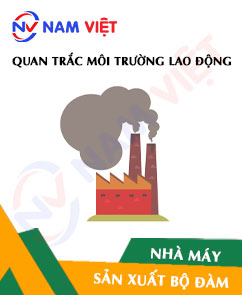
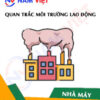
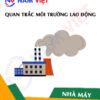
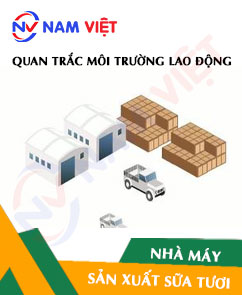





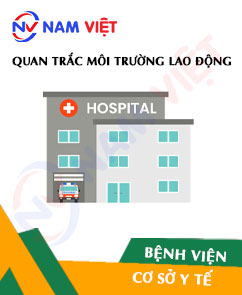

Review Occupational Environment Monitoring at the Walkie-Talkie Manufacturing Factory
There are no reviews yet.